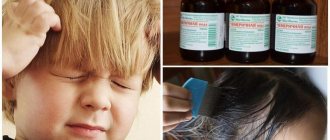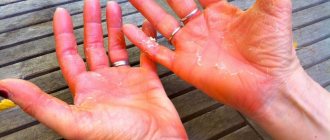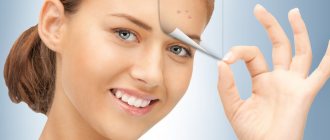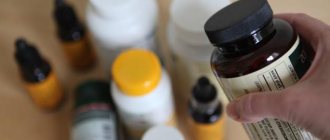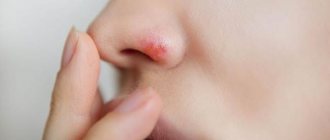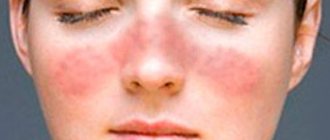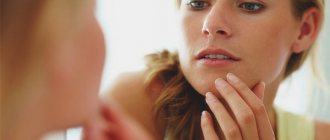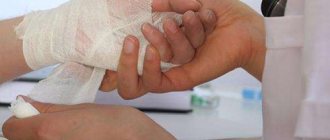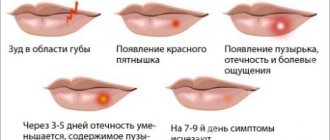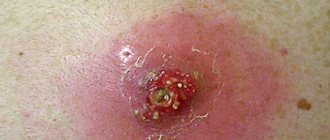Varicose veins are a vascular pathology that is accompanied by chronic venous insufficiency and blood stagnation, mainly in the lower extremities. Due to these processes, the trophism of soft tissues is disrupted, and the skin does not receive enough oxygen and nutrients. As a result, varicose eczema develops, also known as varicose dermatitis. In the absence of timely diagnosis and treatment, the disease is fraught with large-scale tissue degeneration, including the formation of deep non-healing ulcers and sepsis.
Causes
The most important reason why venous eczema develops is stagnation of blood in the veins and disruption of the valves, which leads to insufficient venous outflow. In addition, the following leads to the development of pathology:
- Excess weight that overloads the lower limbs. It is for this reason that varicose eczema can appear at a young age.
- Thrombosis.
- Previous injuries to the lower extremities.
- Heredity.
- Disturbances in the functioning of the cardiovascular system.
- Advanced stage of dermatosis and associated secondary infection.
- Pregnancy.
The development of the disease can be caused by an unhealthy lifestyle, unhealthy diet, a tendency to allergies, wearing uncomfortable shoes or other stress on the feet. Poor vein health can also lead to eczema. Malfunctioning valves change the direction of blood flow, causing the veins to increase in size and increase pressure in them. The skin becomes thinner, wounds and microcracks appear. Such damage can lead to the development of infection and its rapid spread, which leads to the appearance of ulcers on the veins.
Stages
There are 4 known stages of varicose eczema on the legs:
- The first stage includes the initial form of the disease, which can be cured with the help of folk remedies. However, doctors strongly recommend not to waste time, but to immediately contact specialists for advice.
- The second stage is characterized by serious disruption of venous outflow and swelling of the extremities. The main symptoms of eczema appear at this moment.
- At the third stage, the bubbles formed on the skin burst, its surface becomes wet. Nothing prevents infection from occurring, so at this stage all available treatment methods are used.
- The fourth stage is the final one: crusts appear and the disease subsides. However, incorrect treatment tactics can lead to a second wave of varicose eczema on the legs.
As the disease enters the chronic phase, symptoms of sclerosis of the outer layer of skin appear
Education mechanism
Venous eczema goes through several stages:
- Peeling, severe itching and discoloration appear on the skin of the legs. As evening approaches, the itching becomes stronger.
- The limbs swell, erosions, scratching, and blisters with liquid contents appear.
- The epidermis begins to peel off, blisters open, and the skin is constantly moist. Possible infections.
- The inflammatory process gradually passes, the wounds heal, and scars appear.
Symptoms of the disease
In the early stages of the disease, peeling and itching appears on the skin around the veins. Then the skin becomes inflamed, covered with scales, and painful sensations appear. After this, venous eczema is characterized by such symptoms as:
- darkening of the skin occurs due to the destruction of surface vessels and blood entering the cells, which leads to a change in color.
- severe itching - scratching only worsens the situation, since nails can also cause another infection. This can lead to inflammation and even sepsis.
- Swelling of the lower extremities - over time, the swelling becomes more severe, sometimes the patient cannot even put on shoes, it is difficult for him to move and stand still.
- The appearance of open wounds - if the integrity of the skin is violated, secretion and even bleeding may occur. Germs and viruses can enter wounds, which can lead to infection. To prevent this from happening, wounds must be treated with antiseptics. Otherwise, the formation of a trophic ulcer or gangrene is possible.
Compression jersey
Special knitwear improves blood circulation. Socks, stockings, tights are used throughout the day. For severe vein diseases, compression class 2 and 3 underwear is recommended. It optimally distributes pressure on the leg, prevents venous stagnation, reduces swelling, and normalizes blood circulation.
Treatment
The entire treatment process is to improve blood supply to the lower extremities. For this purpose, external medications are used that relieve inflammation and improve skin condition.
One of the main treatment methods is proper skin care and wearing a special bandage. Elastic stockings that compress the leg to the knee are suitable for such purposes. Compression hosiery will improve blood circulation, resulting in proper blood circulation. An elastic bandage is required in cases where there are wet areas of the skin.
A phlebologist treats varicose eczema. It is he who can recommend wearing a bandage that is soaked in Burov’s fluid or zinc gelatin. If these methods do not produce results, the patient is offered surgical intervention.
Sequential gradient vacuum therapy shows excellent results. This procedure improves lymph flow and blood circulation, and also helps fight swelling.
To combat painful itching, antihistamines (Erius, Claritin) are prescribed. Products containing menthol, benzocaine and camphor will also help.
If the functioning of the nervous system is disrupted, sedatives are prescribed. When infections occur, antibiotics and antiseptics are used. Wet eczema is treated with creams and ointments. For dry eczema, it is necessary to use products that soften and moisturize the skin. Baby cream will help relieve flaking and dryness.
To eliminate severe and painful itching, as well as relieve inflammation, it is possible to prescribe drugs such as Lokoid, Advantan and Elokom. But they need to be used in small quantities and in short courses. The acute stage of the disease is treated with steroid drugs; in the generalized form with damage to large areas of the skin, systemic steroids are prescribed.
Local treatment with ointments
The most effective treatment for eczema on the lower extremities can be achieved with the use of ointments. Most often used:
- Skin-Cap - this product is the most popular and effective. It helps restore the skin and prevents the growth of bacteria. The components it contains help fight flaking and itching, as well as redness, swelling and rashes on the skin. The active ingredients of the ointment penetrate quickly and deeply into the dermis, and after just a few hours the patient may notice an improvement.
- Triderm is a hormonal drug that relieves inflammation, itching and allergic manifestations. Used to treat severe forms of the disease.
- Hydrocortisone ointment is a corticosteroid drug that relieves inflammation, itching and swelling.
- Salicylic ointment is an excellent antiseptic that relieves inflammation and has a keratolytic effect.
- Boric ointment - used as an antiseptic.
- Sinaflan is a hormonal drug that helps relieve inflammation, itching and swelling.
Surgery
If the disease has become advanced or severe, the only treatment option is surgery. It is also used if drug therapy has failed. Treatment methods used include:
- Sclerotherapy is the injection of a sclerosant into a vein, which glues blood vessels together.
- Phlebectomy - removal of an infected vein.
- Thrombectomy is the removal of a blood clot that is interfering with the normal functioning of blood flow.
Modern treatment methods involve the use of lasers or high-frequency currents.
Traditional methods
To alleviate the symptoms of the disease, along with drug treatment, you can try traditional methods.
Particularly popular are:
- Wormwood compress. 1 tablespoon of wormwood leaves is ground in a mortar and mixed with 3 tablespoons of sour milk. This mixture is laid out on gauze and applied to the affected area of skin for half an hour. The procedure can be repeated every day. With the help of such a compress you can relieve inflammation and soften the skin.
- Potato compress. You will need to grate fresh potatoes and place the mixture on cheesecloth. After this, apply to the affected area of skin for half an hour, and then rinse with warm water. This will help skin ulcers heal faster.
- Cabbage leaf. You need to take fresh cabbage, tear off a leaf and beat it a little, then put it on the affected area for 2-3 days, and then replace it with a fresh one. Repeat the procedure for 2 weeks.
Traditional methods
Treatment with folk remedies will help you get rid of varicose eczema. It should be part of complex therapy. There are various methods of such treatment.
- Grated potatoes are applied to the sore spot through gauze. Periodically change the compress to a fresh one. Daily procedures will help speed up healing.
- Take one tablespoon of dried wormwood and milk. The mixture should be mixed, applied to a bandage and applied to the inflamed veins. The course is carried out for 4 days, followed by a break and repetition.
- To relieve itching and soften the skin, you can prepare homemade ointment from burdock, fireweed, and chamomile. Take 1 tbsp. each ingredient, mixed with 1 tbsp. oil and with 200 ml of hay dust decoction and place in a water bath. Glycerin is added to the cooled mass and the product is rubbed into the affected areas.
Remedies invented and tested by people over the years will help speed up recovery.
Prevention measures
To prevent the development of varicose eczema, it is necessary to perform a set of measures:
- Take care of your health, eat right and give up bad habits.
- Do not overuse physical activity, but be active.
- Perform daily hygiene procedures and use moisturizers.
- Support immunity.
- Have a full rest.
- Wear only comfortable shoes and clothes so that blood circulates normally.
Prognosis for recovery
Any disease requires diagnosis and treatment, and varicose eczema is no exception. This skin pathology can lead to serious consequences, such as sepsis, gangrene, and trophic ulcers.
If you visit a doctor on time and follow his recommendations, the prognosis for recovery is favorable. However, after a course of treatment, it is necessary to be observed by a dermatologist to exclude relapse.
Varicose eczema is a complex and dangerous disease that requires careful examination and selection of individual treatment. The disease can be completely cured if you seek help from a specialist in time and follow the instructions.
Diagnostics
There is no specific diagnostic method today. Eczema is identified based on history, patient complaints, and physical examination. Each patient has a unique set of symptoms, and the symptoms and course of the disease change periodically.
If a simple medical examination is not enough to make a diagnosis, laboratory tests are performed: general blood test; blood test for allergens; scraping for fungal infection; fecal analysis for helminth eggs. This will help find the potential cause of this disease.
If signs of an allergic reaction are detected, allergic skin tests are prescribed. They will help identify substances that cause allergies in the patient.
Note. In some cases, consultation with specialists such as a phlebologist, allergist, or infectious disease specialist may be required.
Most often, the diagnosis is made during a simple medical examination.
